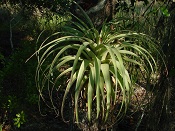**** Save Florida's Bromeliads Conservation Project ****
|
| Following is a summary of the Save Florida's Bromealiads method for conserving Florida's native bromeliads. |
PERMITS
Seven of Florida's native
bromeliads,
including the giant airplant, Tillandsia
utriculata,
are on Florida’s Endangered Plants List. Three bromeliads are on Florida's Threatened Plants List. Permits
are
required for moving and handling these plants. This method
works
with regulatory agencies to make sure proper permitting is done. PLEASE DO NOT HANDLE OR MOVE
THESE PLANTS ON YOUR OWN.
Contact
Teresa Cooper at tmcooper@ufl.edu
to become part of this conservation effort and work with us.
For more information visit the Florida Department of Agriculture and
Consumer Services, Division of Plant Industry:
http://www.freshfromflorida.com/Divisions-Offices/Plant-Industry
|
METHOD
DEVELOPMENT
This
conservation method was
developed based on previous methods
used to monitor bromeliads and weevils in the field in Florida and on
laboratory research ( Frank and
Thomas 1994; Salas and Frank 2001; Frank et al. 2006; Cooper 2006,
2009, Cooper et al. 2014), as well as interactions with land managers and
volunteers at several Natural Areas from January 2015 to December
2015. Two Giant Airplant Workshops,
one in January 2015 and
another in
December 2015, were held where land managers, volunteers, and
scientists met to discuss conservation of the giant airplant in
Florida, including the development and use of this conservation method. This is a standardized method to be
used by many Natural Areas.
It will:
- Provide a method
for
land managers and volunteers to
conserve giant airplants on their land.
- Provide a network
for
land managers and volunteers
from different Natural Areas to communicate about what they are doing on their land.
- Provide consistent
data
collection for the
development of this conservation method and for monitoring our progress.
|
BEGINNING WITH THE GIANT AIRPLANT
Florida
has 16 native species of bromeliads and 12 of those species, plus 2
natural hybrids, are threatened by the weevil (Frank and Cave 2005).
Eventually, we want to include the 11 other species of bromeliads, plus
the hybrids, in this conservation effort. However, the bromeliads have
different life histories and the weevil has different demographics on
the bromeliads, so there will be slight variations in the conservation of these bromeliads. We begin with the
giant airplant because it is the species most in danger of being
extirpated in Florida. Once the method for conserving the
giant airplant is well underway, then we will begin working on saving
Florida's other airplants.
|
TIERED
SYSTEM FOR MAPPING BROMELIADS AND STRUCTURING DATA
The
giant airplants
are conserved in situ on
parks, preserves, sanctuaries, refuges and other managed
lands
(called Natural Areas). The goal is to have many Natural
Areas
throughout central and southern Florida working to conserve a small number
of giant airplants on their lands. This way, we can
collectively
maintain giant airplant abundance and diversity. As well,
because participants will be using the same method, we will be able to
compare and share data. Bromeliads are mapped and data are organized using a tiered system. Sites are locations within the tiers
that are used for managing the giant airplants (Gardens, Protected
Sites, and Recruitment Sites).
Below is a schematic showing
the
tiers and sites, followed by definitions.

TIERS
Central and southern Florida: Range that includes all of Florida's native bromeliads that are threatened by the weevil.
Natural
Areas: Parks,
refuges, sanctuaries, preserves, and other managed lands that have or
have had giant airplant populations and that are participating in this
conservation project.
Region: Bromeliad-supporting habitat in the Natural Areas.
Area: Manageable, mapped area in Regions that contain a contiguous bromeliad population.
Section: An Area is
divided into Sections if the Area is very large and/or has an abundant bromeliad population.
Segment:
Sections
are
divided into Segments if the Area is very, very large.
Bromeliad Host:
The host on which a bromeliad is (or bromeliads are) growing; usually a
tree, but it can be vines, palms, shrubs, well-drained earth, or other.
BROMELIADS
Bromeliads: Mapped bromeliads. Bromeliads include the 12 species
and 2 natural hyrbids threatened by the weevil. Bromeliads are
identified to species; in the diagram, GAP = giant airplant.
SITES
Gardens: Locations
in Natural Areas where giant airplants are purposefully grown and
protected.
Recruitment Sites:
Locations in Natural Areas where seeds and recruit, tiny, and
small
giant airplants are put in the forest, for re-populating the forest
with giant airplants.
Protected Sites: Locations where medium, large, and very large giant airplants
are kept and protected
until they reach reproductive age, at which time the seeds
are returned
to the forest from where the giant
airplants originated.
Some seed may be propagated in the Gardens or in grow
houses. Protected Areas
may
be cages, kept in
the forest of a given Natural Area,
built to hold large giant
airplants;
or bromeliad growers outside of the Natural Area, either
professional
establishments, such as botanical gardens, or private homeowners with
space and knowledge to keep and grow the plants (think
“Adopt-a-Bromeliad” program). If
the giant airplants
leave their Natural Area to go to a Protected Area, permits are required. |
METHOD
SUMMARY
This method
is initially being developed for the giant airplant. Below is a
schematic showing the movement of giant airplants in a Natural
Area.

#1. Recruit, tiny, and small giant airplants are
rescued from the forest floor (where they
would rot and
die if left un-rescued and are taken to Gardens,
where they are grown to medium size (see Giant Airplant Size Categories for sizes).
#2. When giant airplants in a Garden are medium growing into the large
size category, they are
transferred to Protected Sites (on or off the Natural Area; Protected
sites off of the Natural Area require a permit). Conservation cages
are being used on-site to protect giant airplants. Off-site, botanical
gardens, bromeliad growers, and private home-owners may be able to
protect plants ( permit required).
#3. Large, and very large giant airplants are rescued
from the forest and are transferred to Protected Sites where they are
grown until they produce seed.
#4. Giant airplants from the Gardens and from the forest are kept in the Protected Sites until they are about to produce seed.
#5. Seed produced from the giant airplants in the Protected Sites are
put in Recruitment Sites, to re-populate the forests with giant
airplants..
#6. Areas with wild giant airplants are mapped and monitored
annually. Notice
that Gardens, Protected Sites, and Recruitment Sites can be located in
an Area.
#7. Large and very large giant airplants are located by GPS in
un-mapped parts of Regions and are monitored as well as possible.
#8. Seeds from the Protected Sites are propagated in the Gardens, to
supply giant airplants to put back in the Protected Sites in the
future. When the Gardens are able to provide enough giant airplants to
keep the Protected Sites full, then seeds, recruits, tiny, and small
giant airplants will no longer be collected from the forest (#1 and
#3), but will be supplied by the Gardens. This is a conservation
method in its earliest stages and will develop over time. The Conservation Method Progression diagram shows the progression of the method.
And remember, the goal of this conservation method is not to save every bromeliad possible from the weevil.
The goal is to save enough
giant airplants to produce enough seed to keep the forest populated
with giant airplants, until we can find a solution to the Mexican
bromeliad weevil.
|
GIANT
AIRPLANT SIZE CATEGORIES
The giant airplant is a very slow growing plant
that begins very small (leaves that are 0.1 to 0.08 inches (2 to 3 mm)
in length) and finishes very large (leaves longer than 3 feet (1 meter)
and with inflorescences over to 6 feet high (1.8 meters)).
For
this method, the giant airplant is divided into size
categories. The sizes are based on the longest leaf length of
the plant. This is a non-destructive way to measure giant
airplants and estimations can be made even of
those plants that are high in the canopy ( Frank
and Curtis 1981).
The
numbers at the top of the above figure represent
years of growth. It can take 5 to 7 years for a giant
airplant to reach
the size that can support a single weevil. It takes 10 to 20
years for a plant to reach reproductive age. One reason for
growing the giant airplants in Gardens on Natural Areas is because the
forest will provide time and space to grow these slow growing,
eventually very large plants.
Giant airplant mortality is VERY HIGH when the plants are young (Benzing 1980, 2000).
The mortality rate declines as the plants mature and becomes VERY
LOW for large and very large giant airplants. A single giant
airplant can release 10,000 seeds (Isley 1987).
Those seeds ride on the wind and a small portion find a tree
or vine or some other substrate to land on. Of those seeds,
very few germinate. The recruit, tiny, and small giant
airplants are very susceptible to changes in temperature and
humidity and die from drying out or from rotting.
These early stages also suffer mortality when branches break
and vines fall down and trees slough bark or palms shed their boots and
the bromeliads on these substrates fall to the ground and rot. The
weevil does not attack these small plants because they are too small to
support weevil larval growth ( Cooper 2006).
As a giant airplant moves from the small into the medium size category,
it can support a single weevil larva, but plants at this size are not
preferred by the weevil.
Those plants that found purchase on a strong, enduring
substrate move into the medium size category and and the natural
mortality rate starts to decline (Benzing 1980, 2000). However, at this size, the plants become attractive to the weevil and a single plant can support 1 to a few weevil larvae ( Cooper 2006).
The larger the plants become, the more attractive they are to the
weevil. The plants start holding water in their leaf axils and
phytotelmata (plant-contained aquatic ecosystems) begin to form ( Frank and Curtis 1981).
Plants can put out an inflorescence at this size category, but this
usually does not happen until the plant enters the large and very large
size categories..
The large and very large giant airplants are near the reproductive age and are very attractive to the weevil ( Cooper 2006). Mortality rate declines greatly (Benzing 1980, 2000). A giant airplant will put out an inflorescence in spring, flower, then seed pods form and the seeds develop over the year .
The seeds are released the following spring and are viable for only a
short time (which is why we have to continue growing giant airplants to
make seeds). During the process of seed production, the
plant senesces and dies. The weevil can attack and kill a giant
airplant even after the inflorescence has emerged and the seeds are
being developed (Frank and Thomas 1994, Cooper 2006,
2009, Cooper et al. 2014). The weevil is so damaging to giant airplant
populations because it is causing such a drastic reduction in seed
production .
If the giant airplant is extirpated in Florida, it will not be because
the weevil ate the very last giant airplant, it will be because giant
airplant seed output has fallen below a sustainable level.
|
CONSERVATION METHOD
PROGRESSION
The
diagram below illustrates the progression of this conservation
method and how the Gardens, Conservation Cages, and Areas and Regions
are used together on a Natural Area to conserve the giant airplant and
to monitor our progress. Everything that happens, as represented in
this diagram, happens on the Natural Area where the giant airplants
grow, and with the permission of the land manager. Protected Sites may
be located off of a Natural Area and would function as the cages do as
outlined in this diagram; Protected Sites not located on Natural Areas
require permits.
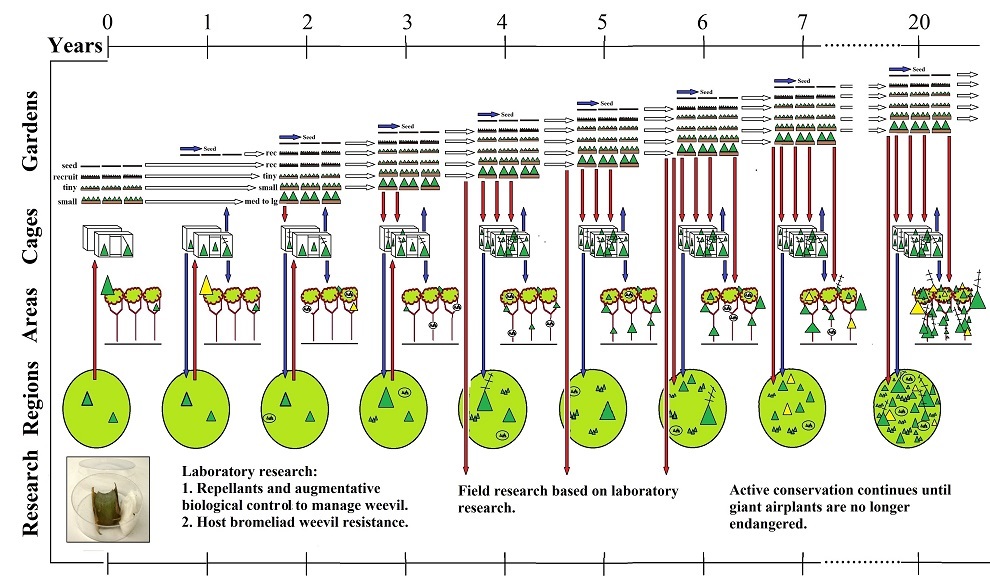
The progression of this method is broken down below and explained year by
year. Green triangles represent living giant airplants and yellow triangles represent giant airplants killed by the weevil.
|

|
Year 0
Gardens are set up using seeds
and recruit, tiny, and small giant airplants that are rescued from
the forest floor or other precarious situations where the plants would
likely die if not rescued. The giant airplants are grown on Garden
structures.
Cages are built for holding and protecting large and vey large giant
airplants that are rescued from the forest, either from the forest
floor or from the canopy, where they can be safely reached. *
Areas with wild giant airplant populations are mapped using transects
and baseline counts of the giant airplants in the Areas are made.
Only giant airplants with a longest leaf length of 12" (30 cm) or
greater are counted.
Large and very large giant airplants are located and mapped in Regions using GPS.
|
 |
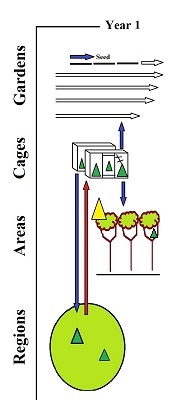
|
Year 1
Rescued plants continue to grow in the Gardens.
Giant airplants in the cages that produced inflorescences in Year
0 will release seed this year. These plants are removed from the
cages and seeds are used for propagating plants in the Gardens and for
creating Recruitment Sites in Areas and Regions (to repopulate the
forest on the Natural Area). New giant airplants, still rescued from
the forest, are added to the cages.
An annual count of the giant airplants in the mapped Areas is made.
As many large and very large airplants located in the Regions are
re-located and checked for living or dead; seed release or not. New
Areas are mapped as possible.
|
*The
seeds and recruit, tiny, and small giant airplants are rescued from the
forest to get the Gardens started. The large and very large
giant airplants are rescued from the forest to initially supply giant
airplants for the cages and because there are so few remaining large
and very
large giant airplants, they are so close to seed production (and we
need seed to propagate giant airplants in the Gardens and in the
forest), and because they are still vulnerable to weevil attack. As the
method progresses, we will use seeds from the Protected Sites to
propagate giant airplants in the Gardens, to provide large giant
airplants for the cages in the future.
|
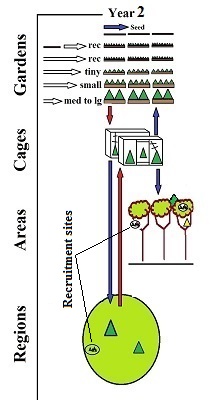
|
Year 2
Some of the small giant airplants
rescued in Year 0 reach a size that can be attacked by the weevil; the
largest of these plants are placed in the cages for protection.
Large giant airplants are still being rescued from the forest if there
is room in the cages after putting the Garden giant airplants in the
cages.
An annual count of the giant airplants in the mapped Areas is made.
New recruits from the seeds that were put out in Year 1 are germinating in the Recruitment Sites in the Areas and Regions.
Large and very large giant airplants located in the Regions are checked as possible. New Areas are mapped as possible. |
 |
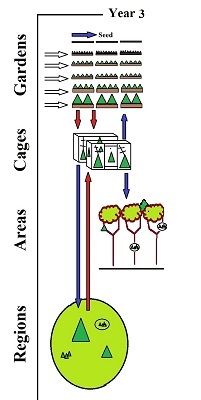 |
Year 3
Some
of the tiny giant airplants rescued in Year 0 reach a size that can be
attacked by the weevil; the largest of these plants, as well as those
from the remaining small giant airplants, will be placed in
the cages for protection.
Large giant
airplants are still being rescued from the forest if there is room in
the cages after putting the Garden giant airplants in the cages.
An annual count of the giant airplants in the mapped Areas is made.
New recruits from the seeds that were put out in Year 1 should be germinating in the Recruitment Sites.
Large and very large giant airplants located in the Regions are checked as possible. New Areas are mapped as possible. |
|
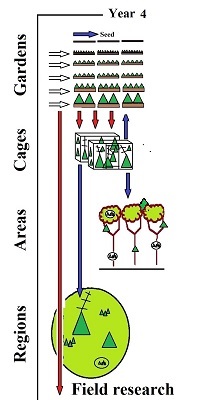
|
Year 4
Some
of the recruit giant airplants rescued in Year 0 reach a size that can be
attacked by the weevil; the largest of these plants, as well as those
from the remaining small and tiny giant airplants, will be placed in
the cages for protection. Some plants are used for field research.**
By now the cages are full and all plants are being supplied by the Gardens.***
Wild annual count is made in Areas.
Seeds from cages are used to create Recruitment Sites and to propagate plants in the Gardens.
Large and very large giant airplants located in the Regions are checked as possible. New Areas are mapped as possible.
Field research continues. |
 |
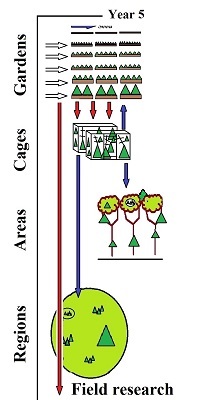 |
Year 5
Seed propagated in Year 0 will be
reaching the tiny size category and there should be a steady stream of
plants available for the cage. This cycle, seed propation, growth,
movement to cage, is kept going. If the cages cannot accomodate all of
the Garden plants, then larger plants are put out in the forest.
The cage is kept cycling plants in from the Gardens and out as they produce seed.
Wild annual count is made in Areas.
Seeds from cages are used to create Recruitment Sites and to propagate plants in the Gardens. Seedlings put out in Year 1 are tiny giant
airplants growing into the small size category. There are several
Recruitment sites.
Large and very large giant airplants located in the Regions are checked as possible. New Areas are mapped as possible.
Field research conintues.
|
**Field research testing biopesticides, repellants, and host plant resistance.
***By using the Garden giant airplants to supply the cage, we can leave
the wild giant airplant population to live without interference.
|
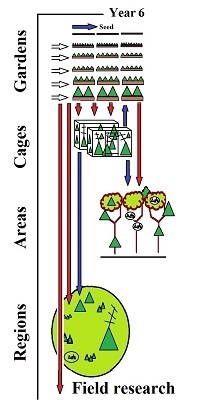 |
Year 6
Gardens are kept cycling.
The cage is kept cycling plants in from the Gardens and out as they produce seed.
Wild annual count is made in Areas.
Seeds from cages are used to create Recruitment Sites and to propagate plants in the Gardens.
Large and very large giant airplants located in the Regions are checked as possible. New Areas are mapped as possible.
Field research continues.
|
 |
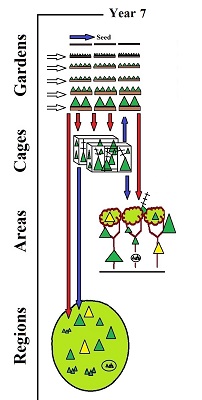 |
Year 7
Gardens are kept cycling.
The cage is kept cycling plants in from the Gardens and out as they produce seed.
Wild annual count is
made in Areas. Seeds put in Recruitment Sites in Year 1 should be
reaching the medium size category which means 1) the plants are large
enough to support weevil larval growth; and 2) those with a longest
leaf length of 12" or greater become part of the annual wild count.
Seeds from cages are used to create Recruitment Sites and to propagate
plants in the Gardens.
Large and very large giant airplants located in the Regions are checked as possible. New Areas are mapped as possible.
Field research should be completed. |
|
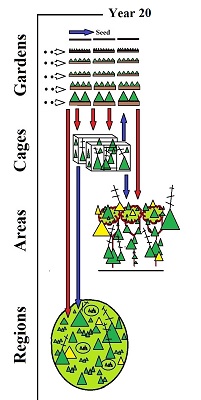 |
Year 20
Gardens continue to cycle.
Cages continue to cycle.
Areas and Regions have many more giant airplants. The weevil continues
to attack the wild giant airplants but, hopefully, by now we will have
a way to control the weevil in our Gardens, allowing us to grow large
and very large plants in the Gardens, as well as protect selected wild
populations that are accessible. There is much more wild seed
production. We continue putting seeds out.
Wild counts in Areas are made annually and large and very large giant airplants located in the Regions are checked as possible.
New Areas are mapped in the Regions as possible. By now, we should be
seeing results from our efforts (how many seeds that we put out in Year
1 reached seed production? How many more giant airplants are in the
mapped Areas and Regions? Are weevil management strategies working?). |
The
above diagram is an ideal version of the development of this
conservation method. There are several parts to be worked out,
including which structures work best for propagating seeds and growing
the giant airplants in the Gardens; which methods of propagating seeds
and plants in the forests are most effective and to refine monitoring
methods of recruitment and growth from germination to medium size;
which cage designs work best for which conditions; and methods for
controlling the weevil using repellants and/or augmentative biological
control as well as host bromeliad weevil resistance.
|
|
|
 |
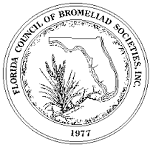
|
|
|
